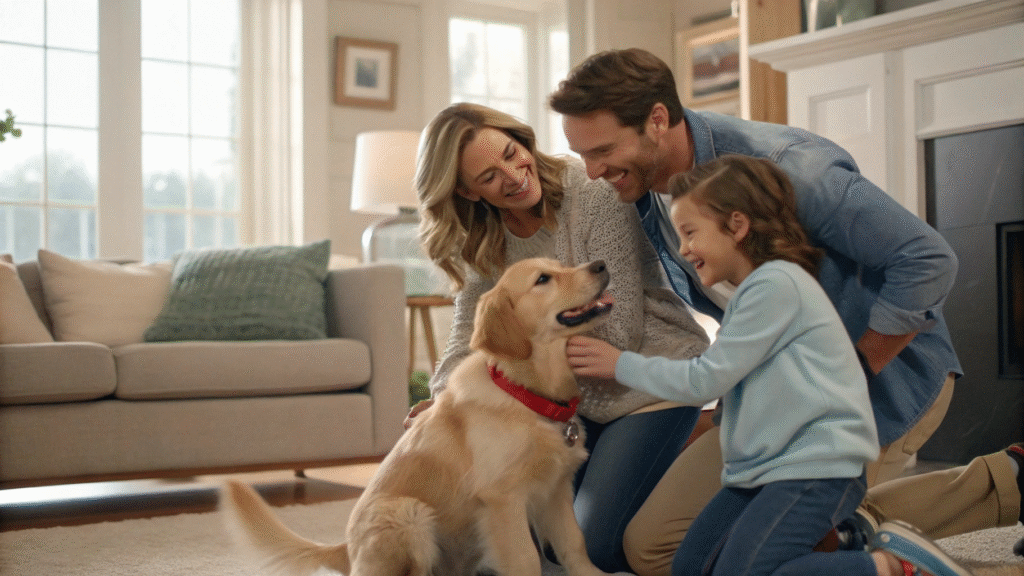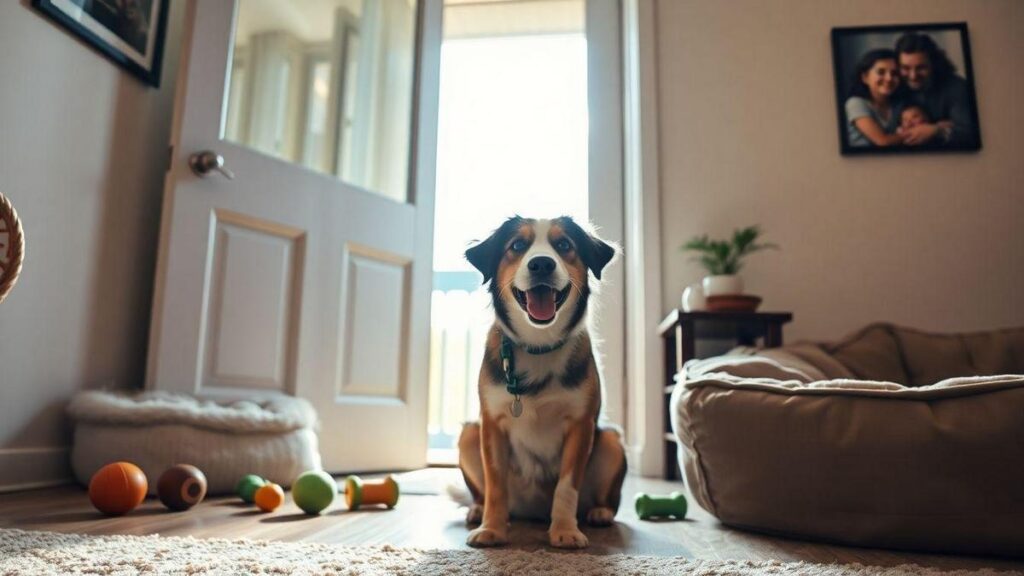Getting ready for a furry friend can be exciting! Easy Ways to Prepare Your Home for an Adopted Dog are out there, and they’ll help you create a safe and happy space for your new buddy.
In this article, you’ll discover tips on dog-proofing your home, what supplies to gather, and how to set up routines that work for both of you.
Let’s dive into making your home the perfect place for your new pup!
Essential Points
- Create a safe space for your new dog.
- Remove any harmful items like chemicals and sharp objects.
- Get dog-friendly toys to keep your pet entertained.
- Make sure your yard is secure to prevent escapes.
- Stock up on food, water bowls, and comfy bedding.
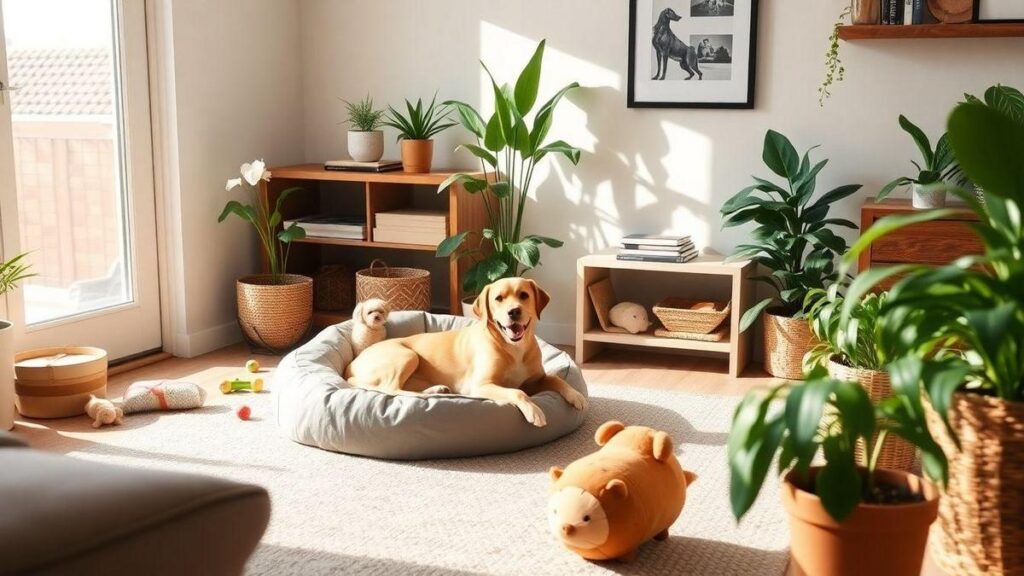
Summary
Why You Should Prepare Your Home for an Adopted Dog
Bringing a new dog into your home is super exciting! But before diving in, it’s important to get your place ready for your new furry friend. Just like you’d baby-proof your home for a toddler, you need to dog-proof it for your new pup. Dogs are curious creatures, exploring their surroundings with their noses and mouths. By preparing your home, you’re not just keeping your pet safe; you’re also protecting your belongings. Plus, it makes the transition smoother for both of you.
Imagine your new dog arriving at your home, tail wagging, ready to explore. If your space is set up for them, they’ll feel more at ease. You want their first experience to be a happy one, right? So, let’s get into the nitty-gritty of how to prepare your home for an adopted dog.
Dog-Proofing Your Home: Easy Ways to Prepare Your Home for an Adopted Dog
Dog-proofing your home doesn’t have to be a huge chore. It can actually be kind of fun! Start by walking through your house and looking at things from your dog’s perspective. Here are some easy steps to get you started:
- Hide Hazardous Items: This includes cleaning supplies, medications, and anything else that could be harmful if ingested. Lock them away in cabinets or high shelves. Dogs are like little detectives, and they love to sniff out anything that smells interesting!
- Secure Cords and Wires: Dogs, especially puppies, love to chew. Tuck away any electrical cords or wires using cord covers or tape them down to the wall.
- Remove Small Objects: Look for small items that could be choking hazards—like coins, buttons, or kids’ toys. It’s better to be safe than sorry!
- Check Your Plants: Some plants are toxic to dogs. Do a quick check and either remove or relocate any harmful plants. You can find out more about safe and unsafe foods for dogs to ensure their safety.
- Create a Dog-Free Zone: If there are areas in your home that you want to keep off-limits, consider using baby gates to prevent access.
- Secure Your Trash: Dogs are notorious for rummaging through trash cans. Invest in sturdy trash cans with tight-fitting lids to avoid messes.
- Clear the Floor: Pick up shoes, clothes, and anything else that might tempt your dog to chew.
- Check Fencing: If you have a yard, inspect your fence for any gaps or holes to ensure your dog can’t escape during playtime!
By taking these simple steps, you’re setting the stage for a safe and happy home for your new best friend.
Creating a Safe Space for Your New Furry Friend
Once you’ve dog-proofed your home, it’s time to create a special space just for your new pup. This is where they can feel comfortable and secure. Here’s how to set it up:
- Choose a Quiet Spot: Find a corner in your home that’s away from the hustle and bustle. Your dog will appreciate having a peaceful place to retreat when they need downtime.
- Add a Cozy Bed: Invest in a good-quality dog bed that’s the right size for your dog—big enough for them to stretch out but not too big that they feel lost in it.
- Include Their Favorite Toys: Stock up on a few toys to keep your dog entertained. Chew toys, squeaky toys, and interactive puzzles are great options.
- Provide Water and Food Bowls: Set up a designated feeding area with bowls for food and water. Stainless steel bowls are a good choice since they’re easy to clean and durable.
- Add a Blanket or Towel: A familiar scent can help your dog feel more secure. If you have a blanket or towel that smells like you, toss it in their space.
- Consider a Crate: If you’re comfortable with it, a crate can be a safe haven for your dog. Introduce it gradually and positively.
Creating a safe space for your dog is all about making them feel welcome and comfortable. It’s their little corner of the world, and it’ll help them settle in more quickly.
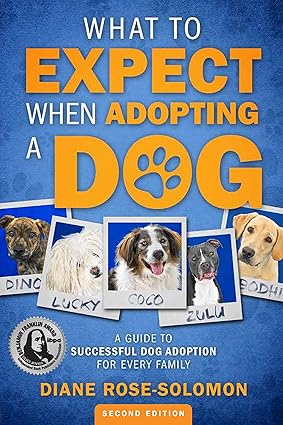
Essential Dog Supplies You’ll Need Before Bringing Them Home
Now that you’ve dog-proofed your home and created a safe space, it’s time to gather some essential supplies. Here’s a handy checklist to get you started:
- Food and Water Bowls: You’ll need sturdy bowls for feeding and hydration. Consider getting a mat to catch spills.
- High-Quality Dog Food: Talk to your vet about the best food for your dog’s age, size, and breed. You want to start them off on the right paw! For more insights on dog nutrition, check out the ultimate guide to preparing natural meals for your dog.
- Collar and Leash: A good collar with an ID tag is a must. Don’t forget a sturdy leash for walks and outdoor adventures.
- Dog Bed: A comfy bed is essential for your pup’s relaxation.
- Toys: Stock up on a variety of toys. Chew toys, balls, and interactive toys will keep your dog entertained and mentally stimulated.
- Grooming Supplies: Depending on your dog’s coat, you might need brushes, nail clippers, and shampoo.
- Dog Crate: If you decide to use a crate, make sure it’s the right size and comfortable for your dog.
- Training Supplies: Consider getting some treats for training. Positive reinforcement is a great way to teach your dog new commands. For more on training, refer to the dog training basics every new owner should know.
- Pet Insurance: This isn’t a physical supply, but it’s worth considering for unexpected vet bills. Explore options with dog health insurance.
Having these essential supplies ready before your dog arrives will make the transition smoother for both of you. You’ll be all set to welcome your new buddy home!
Tips for Establishing a Routine for Your Adopted Dog
Dogs thrive on routine. It gives them a sense of security and helps them know what to expect. Here are some tips for establishing a routine with your new furry friend:
- Set a Schedule: Try to feed your dog at the same times each day. Consistency helps them feel more secure.
- Regular Walks: Aim for daily walks at the same time. It’s not just good for their physical health; it’s also a great bonding experience. Discover how daily walks improve dog behavior.
- Playtime: Schedule regular play sessions. Whether it’s fetch in the yard or tug-of-war in the living room, playtime is essential for your dog’s happiness.
- Training Sessions: Incorporate short training sessions into your routine. Even just 5-10 minutes a day can make a big difference in your dog’s behavior.
- Quiet Time: Just like people, dogs need downtime. Include quiet time in their routine for rest and relaxation.
- Socialization: If possible, expose your dog to new environments, people, and other dogs. It helps them become well-adjusted and confident. For more on this, read about essential tips for dog adoption.
- Be Patient: It might take some time for your dog to adjust to their new routine. Be patient and give them the time they need to settle in.
Establishing a routine not only helps your dog feel secure but also strengthens the bond between you two. Plus, it makes life a lot easier for both of you!
Making Your Home a Pet-Friendly Environment
Making your home pet-friendly goes beyond just dog-proofing. It’s about creating an environment where your dog can thrive. Here are some ideas to help you out:
- Designate Dog Areas: Create specific areas in your home for your dog, like a cozy corner for their bed or a space for their toys.
- Use Pet-Friendly Fabrics: If you’re considering new furniture, look for pet-friendly fabrics that are easy to clean.
- Keep Breakables Out of Reach: Move valuable items to higher shelves or places where your dog can’t reach.
- Create a Dog-Friendly Yard: Ensure your outdoor space is safe for your dog by removing toxic plants and securing the fencing. For more on this, check out fruits and vegetables your dog shouldn’t eat.
- Install Non-Slip Rugs: Use non-slip rugs to prevent your dog from slipping on hardwood or tile floors.
- Provide Shade and Water: If your dog will spend time outside, ensure there’s plenty of shade and access to fresh water.
- Consider Dog Gates: Use dog gates to limit your dog’s access to certain areas, keeping them safe.
Creating a pet-friendly environment means thinking ahead and making adjustments that benefit both you and your dog.
Dog Training Basics Every New Owner Should Know
Training your dog is one of the most important things you’ll do as a new owner. It helps build a strong bond and ensures good behavior. Here are some basic training tips to get you started:
- Positive Reinforcement: Reward your dog with treats, praise, or playtime when they do something right. It encourages them to repeat the behavior.
- Be Consistent: Use the same commands and signals every time. Consistency helps your dog understand what you want from them.
- Keep Sessions Short: Aim for 5-10 minute training sessions to keep them engaged.
- Start with Basic Commands: Teach basic commands like sit, stay, and come. These are essential for good behavior and safety.
- Socialization is Key: Expose your dog to different environments, people, and other dogs to help them become well-adjusted. For more on this, refer to the 5 essential tips for dog adoption.
- Patience is Crucial: Training takes time, so be patient with your dog. Celebrate small victories and don’t get discouraged.
- Seek Professional Help if Needed: If you’re struggling with training, seek help from a professional dog trainer for valuable guidance.
Training your dog is a rewarding experience that strengthens your bond and helps your pup become a well-behaved member of your family.
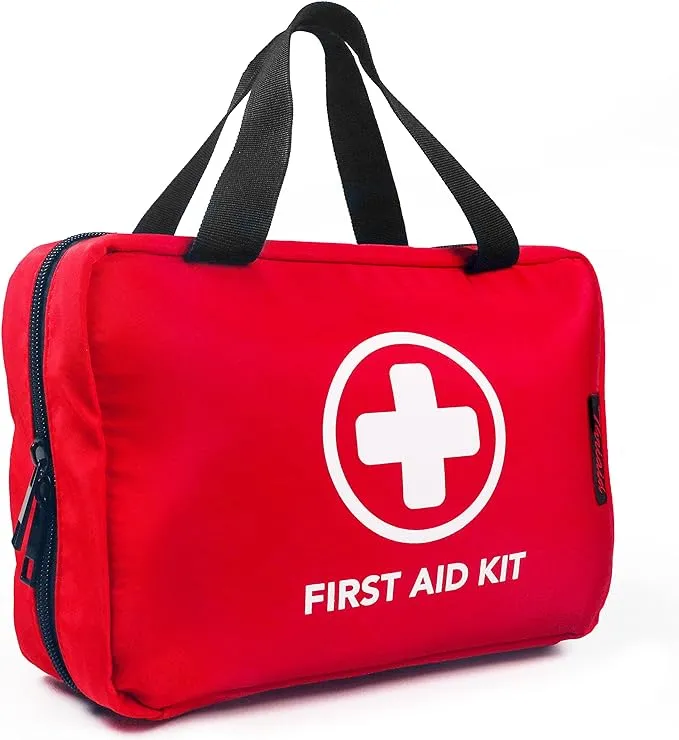
Home Safety for Pets: Keeping Your Dog Safe and Happy
Keeping your dog safe at home is a top priority. Here are some important safety tips to consider:
- Secure All Windows and Doors: Ensure all windows and doors are secure. Dogs can be escape artists, so double-check locks and screens.
- Beware of Toxic Foods: Keep toxic foods like chocolate, grapes, and onions out of reach and educate yourself on what’s safe. For a comprehensive list, check foods dogs can and cannot eat.
- Avoid Leaving Dogs Alone in Hot Cars: Never leave your dog alone in a parked car, even for a few minutes, as temperatures can rise quickly.
- Keep an Eye on Small Objects: Small items like coins and batteries can be choking hazards. Keep these out of reach.
- Regular Vet Check-Ups: Schedule regular vet visits to ensure your dog stays healthy. Vaccinations and preventative care are crucial. Look into dog health insurance for peace of mind.
- Watch for Signs of Illness: Be aware of any changes in your dog’s behavior or health. If something seems off, contact your vet.
- Create a First Aid Kit: Having a pet first aid kit on hand can be a lifesaver. Include items like bandages, antiseptic wipes, and necessary medications. For more tips, explore dog first aid tips.
By taking these safety precautions, you’re ensuring that your home is a safe haven for your new dog.
Pet Adoption Tips: What to Expect When Adopting a Rescue Dog
Adopting a rescue dog is a beautiful thing, but it comes with its own challenges and rewards. Here are some tips to help you navigate the process:
- Be Prepared for Adjustment: Your new dog might need time to adjust to their new environment. Be patient and give them the space they need.
- Understand Their Background: Many rescue dogs come from tough situations. Understanding their history can help you be more empathetic.
- Start Slow: Don’t overwhelm your new dog with too much too soon. Allow them to explore their new home at their own pace.
- Establish Trust: Building trust takes time. Be gentle and patient, and let your dog come to you when they’re ready.
- Be Mindful of Triggers: Some rescue dogs may have specific triggers based on their past experiences. Be observant and adjust your approach as needed.
- Join a Support Group: Consider joining a local or online support group for rescue dog owners to share experiences and get advice. Explore adoption hacks to simplify the process.
- Celebrate Small Wins: Every little progress is a win! Celebrate the small milestones in your dog’s adjustment process.
Adopting a rescue dog is a rewarding journey filled with ups and downs. With love, patience, and understanding, you can create a beautiful life together.
Conclusion
So there you have it! Preparing your home for an adopted dog is not just about making it safe; it’s about creating a welcoming haven for your new furry friend.
From dog-proofing your space to establishing a comforting routine, every step you take helps ensure a smooth transition for both you and your pup. Remember, patience and love are your best allies in this journey.
Don’t forget to keep exploring more pet care tips! For more articles that will help you navigate the exciting world of pet ownership, head over to Tech Havela. Happy tail-wagging adventures await!
Frequently Asked Questions
What are some easy ways to prepare my home for an adopted dog?
Make sure to dog-proof your space. Remove harmful items, keep food out of reach, and secure cords.
Do I need to buy special dog food and bowls?
Yes! Get high-quality dog food and non-tip bowls. Your dog will appreciate it!
Should I create a designated space for my new dog?
Absolutely! Set up a cozy area with a bed, blankets, and toys. It’s a safe haven for them.
What safety measures should I take before bringing a dog home?
Check for hazards! Move sharp objects, close off stairs, and keep chemicals locked away.
Can I use my current furniture with a new dog?
You can, but protect it! Use covers or throws to keep your furniture safe from scratches and fur.
Is it necessary to buy toys for my adopted dog?
Yes, toys are important! They keep your dog entertained and mentally stimulated.
How can I introduce my new dog to my family and other pets?
Take it slow! Let them smell each other first and supervise their interactions for a while.
**Sidnir Vieira**
Founder of TechHavela
A passionate pet and tech content creator, helping dog owners across the U.S. make smarter decisions for their furry friends.


